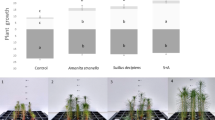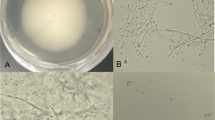Abstract
The effect of different dosages of thymol alone, iprodione alone and combinations of thymol and iprodione on white rot disease of garlic and its impact on soil microbial community structure were investigated under greenhouse conditions. Thymol alone or in combination with the fungicide iprodione did not appear to reduce either white rot incidence or soil sclerotia density as compared to an infected control. However, iprodione alone or in combination with thymol reduced soil fungal biomass. In addition, iprodione alone decreased soil microbial activity as estimated by fluorescein diacetate (FDA). Soil bacterial community structure as estimated by phospholipid fatty acid (PLFA) profiles was also was affected by both thymol and iprodione applications. The correlation biplot of the individual PLFAs and biocide treatment indicated that the treatments with thymol alone increased cyclopropyl fatty acid (cy17:0 and cy19:0), while the treatments with iprodione alone increased some saturated and branched fatty acids (principally i16:0, a15:0 and 18:0). In addition, taking into account PLFA biomarkers, thymol applications reduced Gram-negative bacteria in soil. To our knowledge, this research is the first report about the effect of a monoterpene (thymol) on soil microflora.





Similar content being viewed by others
References
Adam G, Duncan H (2001) Development of a sensitive and rapid method for measurement of total microbial activity using fluorescein diacetate (FDA) in a range of soils. Soil Biol Biochem 33:943–951
Bendahou M, Muselli A, Gringnon-Dubois M, Benyoucef M, Desjobert J-M, Bernardini A-F, Costa J (2008) Antimicrobial activity and chemical composition of Origanum glandulosim Desf essential oil and extract obtained by microwave extraction: comparison with hydrodistillation. Food Chem 106:132–139
Bossio DA, Scow KM (1998) Impacts of carbon and flooding on soil microbial communities: phospholipids fatty acid profiles and substrate utilisation pattern. Microb Ecol 35:265–278
Chirnside AEM, Ritter WF, Radosevich M (2007) Isolation of a selected microbial consortium from a pesticide-contaminated mix-load site soil capable of degrading the herbicides atrazine and alachlor. Soil Biol Biochem 39:3056–3065
Coventry E, Noble R, Mead A, Whipps JM (2002) Control of Allium white rot (Sclerotium cepivorum) with composted onion waste. Soil Biol Biochem 34:1037–1045
Coventry E, Noble R, Mead A, Marin FR, Perez JA, Whipps JM (2006) Allium white rot suppression with composts and Trichoderma viride in relation to sclerotia viability. Phytopathology 96:1009–1020
Cristani M, D’Arrigo M, Mandalari G, Castelli F, Sarpietro MG, Micieli D, Venutti V, Bisignano G, Saija A, Trombetta D (2007) Interaction of four monoterpenes contained in essential oils with model membranes: implications for their antibacterial activity. J Agric Food Chem 55:6300–6308
Davies JML, Savineli C (1994) Control of Allium white rot (Sclerotium cepivorum) in module-raised onions with fluazinam. In: Entwistle AR, Melero-Vara JM (eds) Fifth International Workshop on Allium white rot. Instituto de Agricultura Sostenible, Córdoba, pp 117–122
Davis R, Hao JJ, Romberg MK, Nunez JJ, Smith RF (2007) Efficacy of germination stimulants of sclerotia of Sclerotium cepivorum for management of white rot of garlic. Plant Dis 91:204–208
Duah-Yentumi S, Johnson DB (1986) Changes in soil microflora in response to repeated applications of some pesticides. Soil Biol Biochem 18:629–635
Entwistle AR (1990) Root diseases. In: Rabinowitch HD, Brewster JL (eds) Onions and allied crops agronomy, biotic interactions, pathology and crop protection, vol II. CRC Press, Boca Raton, pp 103–154
Feeney DS, Hallett PD, Rodger S, Glyn Bengough A, White NA, Young IM (2006) Impact of fungal and bacterial biocides on microbial induced water repellency in arable soil. Geoderma 135:72–80
Gill AO, Holley RA (2006) Disruption of Escherichia coli, Listeria monocytogenes and Lactobacillus sakei cellular membranes by plant oil aromatics. Int J Food Microbiol 108:1–9
Guckert JB, Antworth CP, Nichols PS, White DC (1985) Phospholipid ester-linked fatty acid profiles as reproducible assays for changes in prokaryotic community structure of estuarine sediments. Soil Biol Biochem 31:145–153
Högberg N (2006) Discrepancies between ergosterol and the phospholipid fatty acid 18:2ω6,9 as biomarkers for fungi in boreal forest soils. Soil Biol Biochem 38:3431–3435
Isman MB (2000) Plant essential oils for pest and disease management. Crop Prot 19:603–608
Klose S, Acosta-Martínez V, Ajwa HA (2006) Microbial community composition and enzyme activities in a sandy loam soil alter fumigation with methyl bromide or alternative biocides. Soil Biol Biochem 38:1243–1254
Kordali S, Cakir A, Ozer H, Cakmakci R, Kesdek M, Mete E (2008) Antifungal, phytotoxic and insecticidal properties of essential oil isolated from Turkish Origanum acutidens and its three components, carvacrol, thymol and p-cymene. Bioresour Technol 99:8788–8795
Lévesque CA, Rahe JE (1992) Herbicide interactions with fungal root pathogens, with special reference to glyphosate. Annu Rev Phytopathol 30:579–602
Liolios CC, Gortzi O, Lalas S, Tsaknis J, Chinou L (2009) Liposomal incorporation of carvacrol and thymol isolated from the essential oil of Origanum dictamnus L and in vitro antimicrobial activity. Food Chem 112:77–83
Lucini EI, Zunino MP, López ML, Zygadlo JA (2006) Effect of monoterpenes on lipid composition and sclerotial development of Sclerotium cepivorum Berk. J Phytopathol 154:441–446
Ludley KE, Robinson CH, Jickells S, Chamberlain PM, Whitaker J (2009) Potential for monoterpenes to affect ectomycorrhizal and saprotrophic fungal activity in coniferous forests is revealed by novel experimental system. Soil Biol Biochem 41:117–124.
Martínez-Toledo MV, Salmerón V, Rodelas B, Pozo C, González-López J (1998) Effects of the fungicide Captan on some functional groups of soil microflora. Appl Soil Ecol 7:245–255
McKinley VL, Peacock AD, White DC (2005) Microbial community PLFA and PHB responses to ecosystem restoration in tallgrass prairie soils. Soil Biol Biochem 37:1946–1958
Melero-Vara JM, Prados-Ligero AM, Basallote-Ureba MJ (2000) Comparison of physical, chemical and biological methods of controlling garlic white rot. Eur J Plant Pathol 106:581–588
Michiels J, Missotten J, Fremaut D, De Smet S, Dierick N (2007) In vitro dose-response of carvacrol, thymol, eugenol and trans-cinnamaldehyde and interaction of combinations for the antimicrobial activity against the pig gut flora. Livest Sci 109:157–160
Montgomery HJ, Monreal CM, Young JC, Seifert KA (2000) Determination of soil fungal biomass from soil ergosterol analyses. Soil Biol Biochem 32:1207–1217
Pal R, Chakrabarti K, Chakraborty A, Chowdhury A (2005) Pencycuron application to soils: degradation and effect on microbiological parameters. Chemosphere 60:1513–1522
Perucci P, Dumontet S, Bufo SA, Mazzatura A, Casucci C (2000) Effects of organic amendment and herbicide treatment on soil microbial biomass. Biol Fertil Soils 32:17–23
Pinto CMF, Maffia LA, Berger RD, Mizubuti ESG, Casali VWD (1998) Progress of white rot on garlic cultivars planted at different times. Plant Dis 82:1142–1146
Podio NS, Guzmán CA, Meriles JM (2008) Microbial community structure in a silty clay loam soil after fumigation with three broad spectrum fungicides. J Environ Sci Heal B 43:333–340
Sokovic M, Tzakou O, Pitarakoli D, Couladis M (2002) Antifungal activities of selected aromatic plants growing wild in Greece. Nahrung 46:317–320
Thompson DG, Kreutrweiser DP (2007) A review of the environmental fate and effects of natural “reduced-risk” pesticides in Canada. ACS Symp Ser 947:245–274
Tworkoski T (2002) Herbicide effects of essential oils. Weed Sci 50:425–431
Walker A, Brown PA, Entwistle AR (1986) Enhanced degradation of iprodione and vinclozolin in soil. Pestic Sci 17:183–193
Wang Y-S, Wen C-Y, Chiu T-C, Yen J-H (2004) Effect of fungicide iprodione on soil bacterial community. Ecotoxicol Environ Saf 59:127–132
Wauchope RD, Buttler TM, Hornsby AG, Augustijn Beckers PWM, Burt JP (1992) Pesticide properties database for environmental decision making. Rev Environ Contam Toxicol 123:1–57
Zewide T, Fininsa C, Sakhuja PK (2007) Management of white rot (Sclerotium cepivorum) of garlic using fungicides in Ethiopia. Crop Prot 26:856–866
Author information
Authors and Affiliations
Corresponding author
Rights and permissions
About this article
Cite this article
Miñambres, G.G., Conles, M.Y., Lucini, E.I. et al. Application of thymol and iprodione to control garlic white rot (Sclerotium cepivorum) and its effect on soil microbial communities. World J Microbiol Biotechnol 26, 161–170 (2010). https://doi.org/10.1007/s11274-009-0155-7
Received:
Accepted:
Published:
Issue Date:
DOI: https://doi.org/10.1007/s11274-009-0155-7




